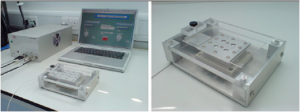The idea:
In about 2005, a sidewalk conversation between Christopher Batich and Jon Dobson at UF led to speculation that better delivery through tissue barriers could take place by oscillating the magnets perpendicular to the main magnetic force on the particles.
Reducing to practice:
Dobson returned to his UK job at Keele University and tried the concept in a prototype. It worked, and a patent disclosure was filed with UF and Keele University as co-owners.
NanoTherics Home Page
Jon Dobson
(Keele University)
return to CTS Page
Commercialization:
investment capital and partners were obtained in the UK, as well as grant support, and a small company was formed to commercialize this and other magnetic technology. The oscillatory gene delivery device has been developed (pictured at the top of this column) sold, and provides a non-viral (or viral-assisted if desired) way to enhance gene delivery to a wide variety to cells at very high levels of transfection and minimal cell damage.
Figure 1:
Early work showing the first delivery of genes (GFP) using permanent magnets and magnetic particles (Mah, Fraites, ,Zolotukhin, Song, Flotte, Dobson, Batich, and Byrne, Molecular Therapy 6[1] 1-7 (2002)). There were still problems with penetrating the mucus present in CF patients.

